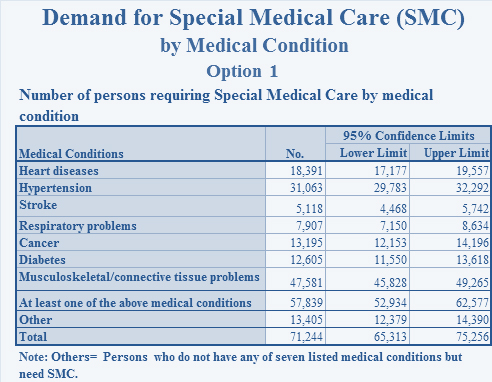MedCon: Pre-Event
A Tool to Estimate the Pre-Event Population at Risk of Medical Consequences in a Disaster
Download Updated Tool [XLSM – 1 MB]
Download Updated Manualpdf icon
Purpose
The MedCon:Pre-Event tool is designed to estimate the baseline medical care requirements (per 100,000 unit of population) following a disaster due to terrorism or natural phenomenon. The tool helps to estimate the number of persons that would require medical care following a disaster for a displaced population with pre-existing medical conditions.
Users of the Tool
The intended users of the MedCon:Pre-Event tool are public health preparedness planners at local, state, and federal levels involved in addressing the large scale medical care requirements resulting from man-made and natural disasters. Users of MedCon:PreEvent should note that the MedCon:Pre-Event has not been designed for estimating the medical care requirements due to direct impact of an event (e.g., injuries and illness) or additional medical care requirements resulting from the aggravation of the existing medical conditions.
Type of Data Needed
To effectively estimate the medical needs following a man-made or natural disaster, the following data types are required:
- Actual size of population affected by disaster
- Rate of hospitalization per day
- Length of hospitalization
- Rate of chronic health conditions (heart problems, hypertension, stroke, diabetes, cancer, respiratory problems, and musculoskeletal/ connective tissue problems) in the given population.
- Rates of nursing home beds requirement by age group
- Rates of special medical care needs by age group
Results
MedCon:Pre-Event outputs include estimates of daily rate of hospitalization, number of expected patients in nursing homes and the demand for special medical care (SMC) in given population.
Sample Output Table:

Downloads Available:
Updated Versions
MedCon:Pre-Event Updated Software (MedCon Version 2.0)*
MedCon Manual Version 2.0pdf icon
Previous Version – Historical Perspective
MedCon:Pre-Event (MedCon Version 1.0)excel icon
MedCon Manual Versioin 1.0pdf icon
*Software was updated using NHIS Data, 2014 (Previous version used NHIS Data, 2006). We developed this updated version to ensure that the pre-existing medical condition estimates reflected a more ideal representation of the current US population.
System Requirements
Medcon: Pre-Event uses the Windows* operating system (Microsoft Windows 2000 or higher) and Excel (Microsoft Office 2000 or higher). We recommend using a computer that has at least a processor with a minimum of 1GB of RAM (operating memory), a 2.5 GHZ speed, and at least 15 MB of free storage memory on the computer’s hard drive.
We have successfully loaded and run MedCon: Pre-Event on a variety of desktop and laptop computers using the Windows operating system. MedCon: Pre-Event is not designed to run on Apple* or machines that use other operating systems such as Linux.+
+Microsoft Windows and Office are copyrighted products produced by Microsoft Corporation, WA. The use of trade named products is for information purposes only. The U.S. Federal Government or its agencies do not endorse any specific computer or operating system.
Disclaimer
The numbers generated through the use of MedCon: Pre-Event should not be considered predictions of what will actually occur during a pandemic. Rather, they should be treated as estimates of what could happen.
References
- National Center for Health Statistics. National Health Interview Survey, 2014. Public-use data file and documentation. https://www.cdc.gov/nchs/nhis/quest_data_related_1997_forward.htm. 2015.
- Aldrich N, Benson WF. Disaster preparedness and the chronic disease needs of vulnerable older adults. Prev Chronic Dis 2008 Jan;5(1):A28 [Epub ahead of print].
- Kennedy BS, Kasl SV, Vaccarino V. Repeated hospitalization and self-rated health among the elderly: a multivariate failure time analysis. Am J Epidemiol 2001;153:232-241.
- NCHS. 2006 National Health Interview Survey (NHIS) Public use data release: NHIS survey description. Hyattsville, Maryland: National Center for Health Statistics, 2007. ftp://ftp.cdc.gov/pub/Health_Statistics/NCHS/Dataset_Documentation/NHIS/2006/srvydesc.pdfpdf icon
- Gavagan TF, Smart K, Palacio H, Dyer C, Greenberg S, Sirbaugh P, et al. Hurricane Katrina: medical response at the Houston Astrodome/Ralient Center Complex. Southern Med J 2006;99(9):933-939.
Correspondence
Please direct all comments and questions to Dr. Martin I. Meltzer (qzm4@cdc.gov) with the Health Economics and Modeling Unit, Division of Preparedness and Emerging Infections, National Center for Emerging and Zoonotic Infectious Diseases
Persons with disabilities experiencing problems accessing this spreadsheet should contact CDC-INFO, (800) 232-4636 or the TTY number at (888) 232-6348 and ask for a 508 Accommodation [PR#9342]. If emailing please type “508 Accommodation [PR#9342]” without quotes in the subject line of the email.